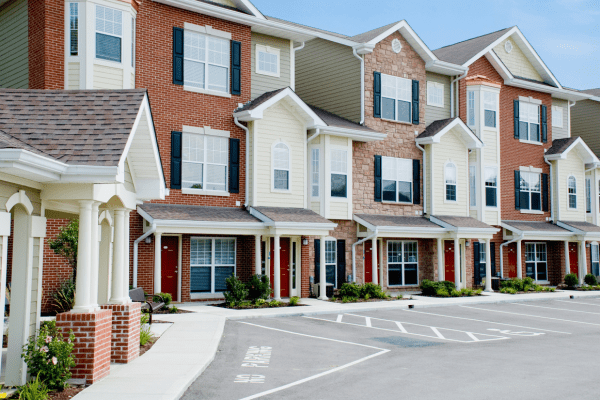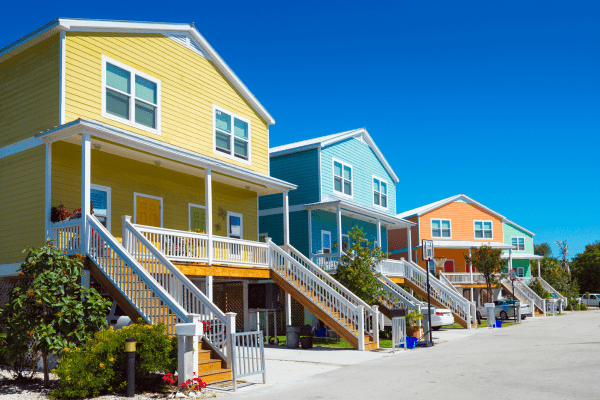 DE
DE
 EN
EN
- Latest News
- What do Americans live like?
What do Americans live like?
When people think of the American Dream, they often picture a house in the suburbs with a white picket fence. But the reality of housing in the United States is much more diverse and complex. Data from the 2020 U.S. Census shows what American housing really looks like today.

- Housing in the USA
- Living in America: metropolises vs. countryside
- Living in the USA: more space, more luxury
- Houses in the USA
- Townhouses in the USA
- Apartments in the USA
- US housing trends through 2020
- Regional differences in housing in the US
- Development of homeownership in the USA
- This is where most homeowners in the US live
- 1. The Villages, Florida
- 2. Holland, Michigan
- 3. Homosassa Springs, Florida
- 4. Punta Gorda, Florida
- 5. Jefferson, Georgia
- 6. Grand Rapids, Minnesota
- 7. Iron Mountain, Michigan-Wisconsin
- 8. Shelton, Washington
- 9. Traverse City, Michigan
- 10. DeRidder, Louisiana
- This is where most immigrants live in the US
- What immigrants need to watch out for when looking for housing in the US
Take the chance of living in the USA and apply for the official US Green Card Lottery!
Housing in the USA
Housing types in the US vary widely, from spacious single-family homes in suburbs to high-rise apartments in bustling cities. The 2020 US Census just analyzed made an additional distinction between homeownership and renting.
Living in America: metropolises vs. countryside
Urban areas in the US are characterized by apartments and townhouses. They offer proximity to jobs and many amenities but often come with a higher cost of living.
The suburbs, on the other hand, are full of single-family homes that symbolize the good old American dream. Here, you have really a lot of space for the family and are virtually in the preliminary stage of life in the country.
Rural America offers you enormous tracts of land and typically very affordable housing. Especially in the Midwest, prices are still moderate and there is plenty of room for personal development. However, depending on your profession, commutes can be long.
Living in the USA: more space, more luxury
American homes often have amenities that would be considered luxuries in Europe. These include fireplaces, air conditioning, large gardens, and ample parking.
The cost of living can be higher in large American cities than in European towns. However, this depends heavily on the respective location and is also offset by correspondingly higher salaries and lower taxes.
Houses in the USA
The average size of a new single-family home in the United States is about 230 m2, according to Statista. These homes often have multiple bedrooms and bathrooms, a large living area, a kitchen, and sometimes a basement or attic.
The standard of construction varies greatly across the United States. Newer homes tend to have modern amenities and are built with contemporary materials, while older homes have a unique architectural charm.
Features of the typical American house
If you want typical American living, take a cue from these common features of US homes:
- Open, spacious rooms, a large living room with an open transition to the kitchen
- Comfortable furniture and a cozy atmosphere
- Decoration and accessories
- Large windows that let in a lot of light and often offer a beautiful view
- Each bedroom has its own bathroom.
- The kitchen is the center of the house, equipped with modern appliances and a kitchen island.
- Garages often provide space for two or more cars and also serve as a storage room or workshop.
Townhouses in the USA
In the US, romantic-looking townhouses are typically multi-story homes that share one or two walls with adjacent lots. They often have smaller yards and are common in both urban and suburban areas.

Similar to single-family homes, these houses are usually equipped with modern amenities. Some are part of communities that offer additional facilities such as swimming pools, gyms, or security services.
Quality and size can vary, but in general, townhouses are well-built and offer more space than apartments but less than single-family homes.
Apartments in the USA
Apartments in the US range from small studios to multi-bedroom lodgings. Many apartment complexes offer amenities such as laundry facilities, fitness centers, and sometimes a community pool or garden area.
Leases are typically for 12 months, although shorter terms are available for an additional fee. As a tenant, you may be responsible for paying utilities separately.
US housing trends through 2020
The US housing landscape has changed significantly over the past 20 years. From bustling cities to quiet suburbs, the total number of housing units has grown steadily, increasing by 21.2 % over the past two decades, according to the U.S. Census.
The numbers reflect not only the growth of the US population but also the changing needs of Americans and immigrants. For example, there is a clear trend toward rental housing, indicating a move away from the conservative American dream of a single-family home.

While the total number of occupied units in the US grew by more than 20 %, the renter-occupied segment outpaced this growth with a 31.1 % increase. This shift can be attributed to several factors, including economic challenges, lifestyle preferences, and the mobility of the modern workforce.
Regional differences in housing in the US
The housing market is not uniform across the United States. Each state has its own pattern, reflecting the different economic and demographic conditions of the country.
The ratio of owner-occupied to rental housing also varies across the states. Analysis of the General Housing Characteristics for the United States data reveals significant trends in changes in housing stock, vacancy rates, and the ratio of owner-occupied to rental housing.
States such as Texas, Florida, and Arizona reported significant increases in the total number of housing units (over 12 % in each case), with notable increases in renter-occupied units, indicating a growing rental market.
States such as Alabama, Arkansas, and Kentucky continued to have a higher share of owner-occupied housing, with both the number of owner-occupied units and the number of renter-occupied units increasing slightly.
States such as New York and California reported significant increases in renter-occupied units (9.9 % and 10.6 %, respectively) despite moderate growth in the total number of housing units.
Development of homeownership in the USA
In 1890, the homeownership rate was 47.8 %, meaning that less than half of all occupied units were owned by residents. In the decades that followed, the rate actually declined slightly, reaching a low of 43.6 % in 1930, during the Great Depression.
It was not until the post-World War II period that a significant change occurred: in 1950, the homeownership rate jumped to 55 %, reflecting the economic boom and the growth of the American Dream in the suburbs.
The trend continued, reaching 61.9 % in 1960 and peaking at 66.2 % in 1980. Since 1990, the homeownership rate has shown signs of stabilizing. It was 64.4 % in 1990 and declined slightly to 64.2 % in 2000. By 2020, the homeownership rate had risen again to over 66 %.
This is where most homeowners in the US live
In 2020, certain Core-Based Statistical Areas (CBSAs) in the United States stand out as having exceptionally high levels of homeownership. These geographically and demographically diverse areas show unique trends in homeownership nationwide:
1. The Villages, Florida
The Villages in Florida lead the way with an impressive 88.3 % ownership rate and is known for its thriving senior community.
Located in Central Florida near cities like Ocala and Orlando, the area offers a mix of recreational and lifestyle offerings tailored to retirees.
2. Holland, Michigan
Holland is proud of its homeownership rate of 82.5 %. Located near Grand Rapids and Muskegon, the city is famous for its annual Tulip Festival and Dutch architecture.
3. Homosassa Springs, Florida
Homosassa Springs is the third most popular place for homeowners to live at 82.1 %. The area near Spring Hill and Tampa is known for its natural springs and abundant wildlife.
4. Punta Gorda, Florida
Punta Gorda has a high homeownership rate of 81.3 %. Located on Florida's Gulf Coast, near Fort Myers and Sarasota, the city is known for its beautiful waterfront lifestyle.

5. Jefferson, Georgia
Jefferson has a homeownership rate of 80.0 % and offers a mix of rural and suburban living. The area is close to Athens and Gainesville and is valued for its small-town atmosphere combined with easy access to larger cities.
6. Grand Rapids, Minnesota
In Grand Rapids, Minnesota, 79.9 % of homes are owner-occupied. Grand Rapids is known for its picturesque scenery and is located near Duluth and Bemidji.
7. Iron Mountain, Michigan-Wisconsin
Iron Mountain is located on the Michigan-Wisconsin border and has a homeownership rate of 79.6 %. The area, near cities like Green Bay and Marquette, is known for its historical significance and attracts people who appreciate a mix of history and nature.
8. Shelton, Washington
Shelton, with its impressive 79.5 % nature connection rate, attracts those who appreciate the beauty of the outdoors. Located near Olympia and the Olympic Peninsula, the city is known for its majestic scenery and close proximity to Washington's natural wonders.
9. Traverse City, Michigan
Traverse City has a homeownership rate of 79.3 % and is known for its picturesque surroundings. Located near Grand Traverse Bay and cities like Cadillac, the city is famous for its vineyards and coves and offers a charming and desirable lifestyle.
10. DeRidder, Louisiana
DeRidder rounds out the top ten with 79 % and is known for its community lifestyle. Located near Lake Charles and Alexandria, the city is known for its historic small-town charm.
This is where most immigrants live in the US
According to the U.S. Migration Policy Institute (MPI), the US states with the most immigrants are California (10.5 million), Texas (5.1 million), Florida (4.6 million), New York (4.4 million), and New Jersey (2.1 million).
As a percentage of the total population, the proportion of immigrants was highest in California (27 %), New Jersey (23 %), New York (22 %), Florida (21 %), Hawaii (19 %), and Nevada (18 %).
Want to know more? The Migration Data Hub interactive maps show the highest concentrations of immigrants at the state, county, or metropolitan area level.
What immigrants need to watch out for when looking for housing in the US
The increase in rental housing meets the needs of many newcomers, who often prefer to rent rather than buy during their first years in the United States. Despite this trend, finding the perfect place to live in the US can be a daunting task. Keep these tips in mind as you search for your new home:
- Stick to verified apartment listings on reputable online platforms like Zillow, Trulia, ForRent and Rent.com.
- Thoroughly research potential landlords before giving out money or personal information.
- Ask the landlord for a previous utility bill as proof of a legal tenancy.
- Possession of a Green Card can make the search for suitable housing much easier.
- Take the time to explore the neighborhood to make sure it meets your needs and preferences.
- Use sources such as the United States Census Bureau to learn about demographics, health care, schools, and employment opportunities in the area.
- Make sure that the required documents, such as your proof of identity and proof of financial security, are translated and, if necessary, notarized.
- Read the lease carefully and contact an attorney who specializes in US landlord-tenant law if things are unclear.
- It is advisable to take out renters insurance to protect against possible financial losses.
Need more help finding your new home in the US? Then you're sure to find what you're looking for in our guides:

